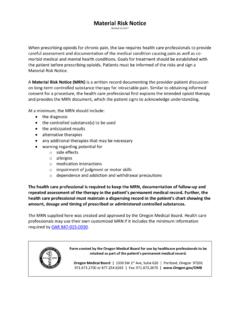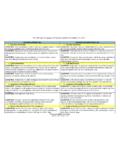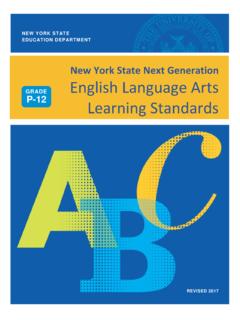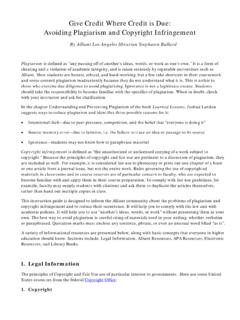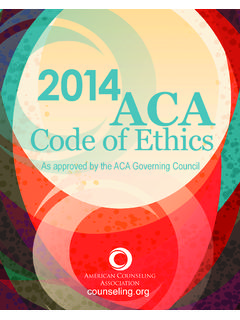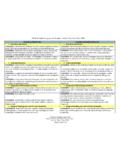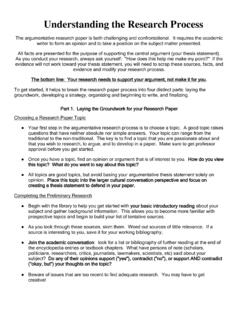Transcription of Student Writing Goals K-12 Writing - Goals
1 Student Goals Writing Goals K-12 Writing - Oregon K-12 Literacy Framework Writing ( Writing Framework). Writing Goals that focus on students' fluency, productivity, Writing quality, and use of the Writing process to write multiple forms of text across the content areas anchor a school's comprehensive Writing plan. Setting and Meeting Measurable Writing Goals aligned to the Common Core: Producing: A critical school responsibility is ensuring K-12 students develop the skills to write fluently, so they are able produce the amount (and quality) of Writing necessary to complete school assignments and other academic tasks. Specifically, fluent handwriting, keyboarding, spelling, vocabulary use, and language use ( , grammar, mechanics, conventions, sentence building knowledge) are essential for proficient, fluent Writing . Adapting written communication: A primary Writing goal across K-12 is that students must adapt their written communication to audience, task, purpose, and discipline, and apply the conventions associated with different Writing genres.
2 Specifically, students must develop proficiency with argument, informational/explanatory, and narrative Writing in the CCSS. Developing coherent written products using the Writing process: K-12. students use all aspects of the Writing process ( , plan, organize, write, edit, revise) to produce high quality, coherent Writing . Goals Writing Writing to Learn: K-12 students must use Writing to think and learn ( , Writing to learn, Writing in the content areas), respond to reading tasks ( , use of written summarization, Writing comprehension questions for class discussion), and research and build knowledge ( , research projects and data gathering). Writing routinely: K-12 students must write frequently and regularly over extended and shorter timeframes. K-12 Writing Goals and the Common Core Meeting or exceeding grade-level formative and summative Writing Goals means that students have met the Common Core State Standards (CCSS) expectations for Writing knowledge and skills.
3 Specifically, students must write fluently and productively; write for a variety of purposes ( , multiple text types) and audiences; purposefully engage in each step of the Writing process; demonstrate their ability to incorporate the mechanics of good Writing in each written text they produce ( , Writing quality); use Writing to learn;. and spend instructional time Writing . Not meeting grade-level formative and summative Writing Goals means that students need additional instructional support designed to improve their opportunities to meet grade level Goals aligned to the CCSS. K-12 CCSS Anchor Standards for Writing : The What of Writing Text Types and Purposes (and subgenres). 1. Write arguments to support claims in an analysis of substantive topics or texts, using valid reasoning and relevant and sufficient evidence. 2.
4 Write informative/explanatory texts to examine and convey complex ideas and information clearly and accurately through the effective selection, organization, and analysis of content. 3. Write narratives to develop real or imagined experiences or events using effective technique, well- chosen details, and well-structured event sequences. Production and Distribution of Writing 4. Produce clear and coherent Writing in which the development, organization, and style are appropriate to task, purpose, and audience. 5. Develop and strengthen Writing as needed by planning, revising, editing, rewriting, or trying a new approach. 6. Use technology, including the Internet, to produce and publish Writing and to interact and collaborate with others. Research to Build and Present Knowledge 7. Conduct short as well as more sustained research projects based on focused questions, demonstrating understanding of the subject under investigation.
5 8. Gather relevant information from multiple print and digital sources, assess the credibility and accuracy of each source, and integrate the information while avoiding plagiarism . 9. Draw evidence from literacy or informational texts to support analysis, reflection, and research. OREGON LITERACY PLAN Oregon K-12 Literacy Framework Writing WG-2. Developed by the Literacy Leadership State Team (LLST) in partnership with the Oregon Department of Education (ODE). Goals Writing Range of Writing 10. Write routinely over extended time frames (time for research, reflection, and revision) and shorter time frames (a single sitting or a day or two) for a range of tasks, purposes, and audiences. Early and Comprehensive Writing Instruction across K-12. Students become proficient writers when they communicate their ideas, thoughts, and opinions effectively.
6 Proficiency can be achieved by providing students with explicit Writing instruction and opportunities to practice the Writing process ( , planning, drafting, revising, and editing) across multiple text types, content areas, and forms of Writing beginning in kindergarten and continuing across the K- 12 grade span. Students who receive strong Writing support on the Common Core State Standards (CCSS) for Writing , beginning in early elementary, will be able to meet grade-level Writing Goals , experience success throughout school as proficient writers, demonstrate proficiency in Writing to earn an Oregon diploma, and be college and career-ready without the need for Writing remediation. The CCSS describe What Writing skills students need at each grade level and K-12 Writing describes How schools can support all students to meet CCSS Writing expectations.
7 Effective written communication requires language use, vocabulary use, and high levels of content understanding . Significant challenges, however, face students who struggle to become proficient writers. At the elementary school level, for example, students who struggle to acquire and demonstrate Writing proficiency are likely to earn lower grades, particularly in classes where Writing is the primary means of evaluating Student skills and knowledge (Cutler & Graham, 2008; Graham, Harris, & MacArthur, 2004). In addition, older students who fail to develop strong Writing skills are unlikely to realize their occupational or personal potential, (Graham, Harris, & Olinghouse, 2007) as evidenced by recent survey data from employers. For any K-12 Student , learning to write can be challenging. Writing is a demanding cognitive process, further complicated by the iterative nature of the Writing process.
8 For example, we write about what we read, and we read what we write. From a Writing perspective, a writer needs to wear multiple hats, know when to change hats, and even understand how to wear some hats simultaneously (Gleason, 1995). Each hat represents a different component of cognitive processing during the Writing process, and each hat requires a different set of skills and strategies. For example, writers need to be Thinkers and Organizers. When wearing the Thinker Organizer hat, the writer determines purpose, anticipates audience, gathers information and sources of evidence, generates ideas, translates ideas, and mentally organizes content. When the writer is wearing the Author hat, he or she organizes the thinker's ideas, generates written ideas, and communicates with an audience. As the Author, the writer also fluently produces text while the Thinker composes.
9 As the Reader, the writer builds coherence from what is read, obtains new ideas, and tells the Editor what to edit. Finally, with the Editor hat, the writer hand-writes or types, punctuates, capitalizes, and indents. The Editor also communicates with the Thinker-Organizer, Reader, and Author about revisions related to the text's purpose, content, and ideas. Writing instruction aligned to the Common Core State Standards (CCSS) introduces these Writing roles at grade-appropriate levels, building college and career- ready Writing skills of integrated cognitive tasks ( hats ) during a 13-year process. Writing is also complex because Writing communicates. In other words, Writing is deeply expressive with profound thought-provoking potential. It is not just Writing ; rather, it is also about the relationship, or written conversation, that is created among readers and other writers.
10 Because Writing is OREGON LITERACY PLAN Oregon K-12 Literacy Framework Writing WG-3. Developed by the Literacy Leadership State Team (LLST) in partnership with the Oregon Department of Education (ODE). Goals Writing communication, it is inherently a social or communal act (Goldberg, 2010). Writing skills, therefore, are socially critical. The ability to write allows the communication of knowledge and ideas, and provides opportunities to articulate a perspective and persuade others (Graham, et al., 2004). Not unexpectedly, students who struggle with Writing are limited in self-expression and are often at a disadvantage when communicating with others (Graham, et al., 2004; Penner-Williams, Smith, & Gartin, 2009). Given the cognitive and social complexities inherent in the Writing process, research indicates that waiting until later grades to begin formal Writing instruction and address Student challenges can be very problematic and that many difficulties students experience are likely to be ameliorated by early instruction (Cutler & Graham, 2008).









